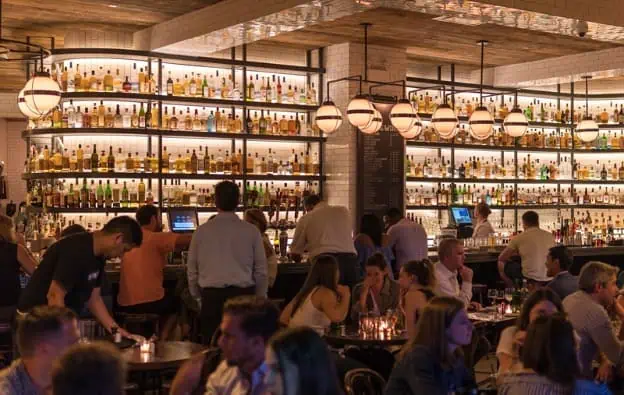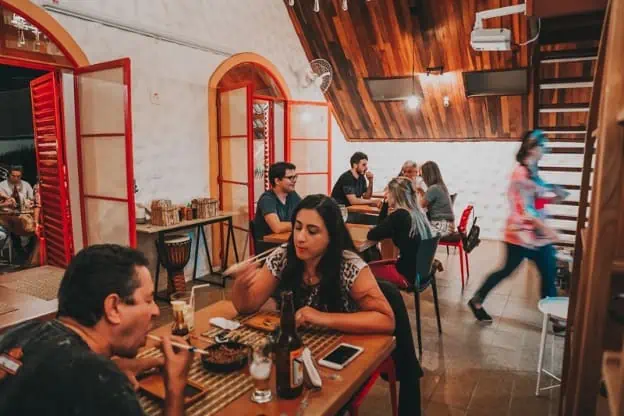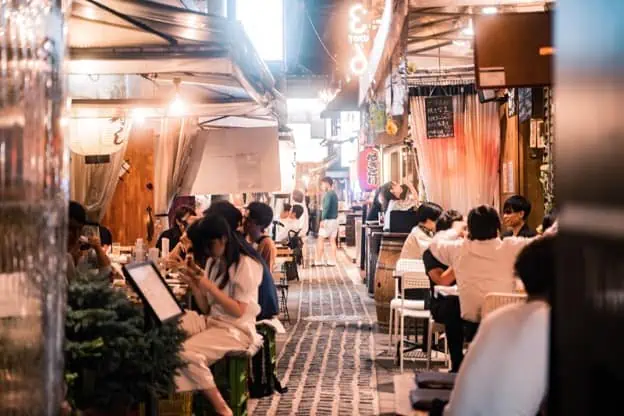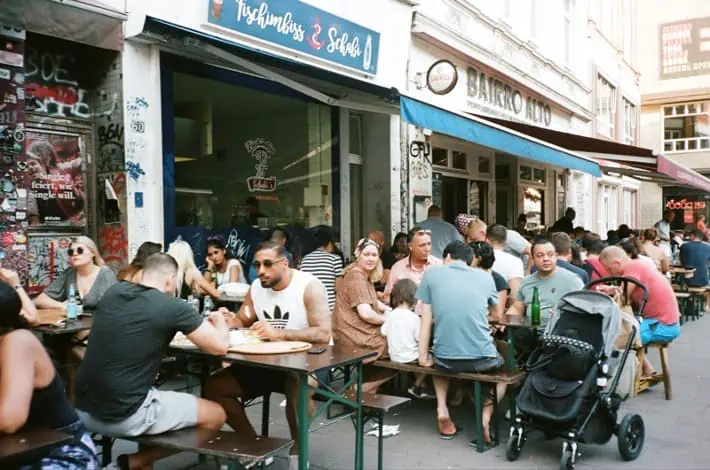When it comes to running a successful restaurant, having an efficient restaurant floor plan can make all the difference. Not only can a well-designed layout help to maximize workflow and reduce waiting times, but it can also improve the overall customer experience.
There are so many different factors to consider for a restaurant floor plan, such as:
- Staffing
- Technology
- Customer flow
- Aesthetics
Constructing an effective floor plan can be a complex and challenging endeavor because of these factors. In this article, we will examine these and share some tips for optimizing your restaurant floor plan.
Our tips will help you create a floor plan that maximizes both customer satisfaction and profitability for your business. Studies have shown that implementing an excellent floor plan can increase your revenue by 25%.
The Importance of a well-designed restaurant floor plan
A restaurant’s floor plan is more than just a diagram of tables and chairs. It is a carefully crafted design that takes into account the flow of both customers and staff. The right floor plan can create a positive atmosphere and increase revenue in the restaurant. While the wrong type of layout can lead to chaos, lost sales and unhappy customers.
Did you know that dividing your restaurant up into sections can improve staff efficiency by 18%? According to a study by the Tailor & Francis, the design and layout of a restaurant can impact customer satisfaction by up to 40%. This means a well-designed floor plan can keep customers coming back, ensures they are happy and increases profits for the business.
Tips for optimizing your restaurant layout for efficiency
When considering factors to optimize your restaurant layout for efficiency, consider the following tips:
- Divide your restaurant into different sections, such as a bar area, waiting area and dining area. This helps to create a sense of order and allows for better traffic flow.
- Place high-margin items such as drinks or appetizers at eye level or in areas where they are easily visible to customers. This can increase sales and encourage customers to order more.
- Keep your restaurant flow in mind when arranging tables and chairs. Make sure the customers can move easily between tables and there is enough space for servers to maneuver.
- Position the kitchen close to the dining area to reduce travel time for servers and minimize the risk of spilling liquids or cold food.
- Utilize technology such as digital menus or mobile ordering to improve the speed of service and reduce wait times.
- The acoustics of your restaurant set the best ambience for your customers. Soft surfaces such as carpets or curtains kind absorb the sound and evoke a more pleasant dining experience.
By dividing your restaurant into sections you can carry out a more streamlined service that minimizes staff movement and maximizes customer flow. Whether you opt for traditional table assignments or embrace more modern seating arrangements, such as communal tables or lounge areas, devising the space creates a more effective and efficient floor plan.
If you implement sectioning strategies you can improve staff efficiency and execute a more seamless dining experience for your customers. Click here to read more about restaurant layouts.

Utilizing technology to improve your restaurants workflow
In the modern digital age, more and more services are going online. Technology has simply become part of everyday life. In order to run a successful restaurant, consider employing these technologies to assist with and ensure smooth management. Technology has revolutionized the way restaurants operate and incorporating it into your floorplan can greatly improve workflow efficiency.
Cutting-edge technology comes in many forms:
- Online ordering
- Mobile payment systems
- Waitlist management apps
- Kitchen automation tools
- Restaurant Paging Systems
All of these can streamline the restaurant’s operations by integrating them into an effective floor plan. You can improve order accuracy and boost customer engagement with these technologies. Using a point-of-sale system can reduce order processing time and prevent server errors. Digital menu boards can help upsell items and provide customers with a more engaging and modern experience.
A study by Software Advice found 87% of customers agree that restaurant technology improves their dining experience, while 64% of restaurant owners believe that technology can increase sales in their business. You can save time and money when using these technologies for your restaurant.
Staff training for effective communication and enhanced teamwork
A well-trained staff is essential for efficient restaurant operations. In addition to providing comprehensive training on menu items and customer service, it’s important to train staff about effective communication, good teamwork and the floor plan.
This can include training on how to handle busy periods, prioritize tasks, customer service skills and the ability to work together to ensure a positive customer experience. This will contribute to the atmosphere within the restaurant.
Moreover, regular training can help your staff remain up to date on the latest industry trends and best practices. According to a study by United Restaurants, restaurants with high-quality training programs have a 15% higher profit margin than those without.
If you implement these practices, you should ensure your staff are always aware of the floor plan and its purpose. These steps will allow your restaurant to stay competitive and enticing to customers. In fact, you will most certainly build up a loyal customer base with these conditions.
Strategies for managing customer flow during peak hours
Are you seeking a floor plan that maximizes customer flow and minimizes wait times? Managing customer flow is essential to achieving this. Peak hours in any restaurant can be a challenge, but with the right strategies you can manage customer flow and ensure an efficient service.
Consider implementing the following tips to assist with these challenges:
- Use a host or hostess to manage the flow of customers and direct them to available tables.
- After a book ahead or reservation service to allow customers to reserve tables in advance.
- Implement a queue management system to keep track of customers’ estimated wait time.
- Provide entertainment or activities to keep Tyst occupied while they wait to be seated. Some examples are games or TV screens.
- Offering a separate menu or quick service options during peak hours to reduce weight times and increase customer satisfaction at these times.
A study by the International Journal of Hospitality Management found that managing customer flow during peak hours can improve customer satisfaction, and increase revenue and customer return rate.
Designing for aesthetics

Did you know that a restaurant design can significantly impact customer satisfaction levels and your overall profitability? A restaurant’s design is a vital component of the overall customer experience. By investing in a well-designed space that reflects the brand’s values and aesthetic, you can create a welcoming and visually appealing environment which will attract more customers and encourage them to stay longer.
From lighting and color schemes to furniture and decor, a restaurant’s design is a critical component of the customer experience. A study found that customers rated the atmosphere and design of a restaurant as one of the most important factors when enjoying their dining experience. Another study found that a well-designed restaurant can increase sales by up to 20%.
By prioritizing the aesthetics of your restaurant’s design, you can create an environment that delights your customers and encourages them to return. Every detail counts when it comes to creating an unforgettable dining experience.
Benefits of regular floor plan evaluations and updates
As your restaurant evolves it is crucial that your floor plan should evolve with it. This is why it’s important to regularly evaluate and update your restaurant floor plan. Updates ensure that it continues to meet your needs, as well as provide an optimal customer experience.
This can include updating the layout to accommodate new technologies, reconfiguring tables and chairs to better suit customers’ needs, or adjusting the flow of the restaurant to improve efficiency and add to the atmosphere.
Why implement a floor plan in a restaurant?

A well-designed restaurant floor plan is crucial for ensuring efficient workflow and customer satisfaction. By incorporating the tips and advice outlined in this article you can achieve immense results with the aid of your staff’s efficient work. Click here to read more information about restaurant layouts.
It is also worth noting that an effective floor plan is not a static concept. Instead, it should be viewed as a constantly evolving aspect of your restaurant’s operations. By regularly evaluating and updating the floor plan, you can stay ahead of the curve and ensure your restaurant remains competitive and appealing to customers.
It is also worth noting that you should stay up to date with the latest trends and technologies and be open to experimenting with new ideas to remain relevant in the restaurant and food industry.
With the right strategies in place, you can achieve excellence with the assistance of your staff. Remember a good floor plan can make all the difference in creating an exceptional customer experience and generating repeat business.
Author Bio

Brodie Gee is a content writer and strategist, based in London, UK. He has been working in social media and content creation for six years. He specializes in tech, business and marketing sectors.

